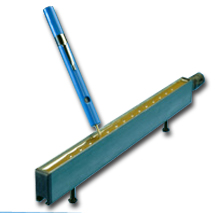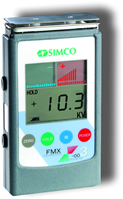AMAZON multi-meters discounts AMAZON oscilloscope discounts
How does one measure and control static in an industrial environment?
Static electricity can be defined as an electrical imbalance of a material that can interrelate with other materials. An atom has the positively (+) charged Protons and negatively (-) charged Electrons in equal numbers and force. This equilibrium is vitiated when an Electron leaves the atom (Protons don't migrate) and the atom becomes positive. The charge thus created is stagnant and can be either on the surface or volumetric.
This condition often causes serious problems to men, machines and materials particularly in electronic, textile, plastic, paper and other industries that use or produce nonconductive materials. The loss resulting from static electricity is colossal in the United States. It includes injury, sometimes fatal, to workmen from shock, damage to machinery and equipments, and poor quality of the product. It is imperative to measure, control and diffuse this dangerous charge.
In conductive materials, static electricity can be grounded. But where non-conductive materials are involved, the ideal way to neutralize static charge is to follow the adage 'opposites attract'. If particles which have opposite polarization to the ones present are released, they draw each other and diffuse the charge. This is known as ionization.
For this function, static bars are cost efficient. They have ionizing points that emit both positive and negative charged particles known as ions. Once the static charge that is causing problem is located and its magnitude assessed, static bars can be placed strategically near the trouble spot. It would be prudent to consult an expert before undertaking this job.
There are different types of static bars. Some are short. Others are long and rigidly-constructed to avoid intermediate support. Portable ones offer flexibility. A shockless bar is available for installing in areas where the chance of personnel coming into contact with it exists.
Maintenance is simple. Keep the bars clean and they will give extended service.
A Static Bar Checker (image below) is an accurate, easy-to use device which allows one to quickly determine if a static bar is working.
It can be used on both shockless and "hot" static bars.
No batteries are needed as this unit is powered by the emissions from the static bar being tested. An insulated housing to prevent the user from being shocked and it is small enough to fit in a shirt pocket (approximately 5 inches long and 7/16 inches in diameter).

Above: A Static Bar Checker from SIMCO.
Static can be measured using an Electrostatic Fieldmeter
The FMX-003 from SIMCO (image below) measures static voltages within +/- 22kV (22,000V) at a distance of 1". Results are simultaneously displayed numerically and in bar graph format. POWER on/off, ZERO adjustment, Ion Balance (IB) and HOLD are all push button operation. The HOLD button allows the display to retain the static charge reading. This is especially useful where display is difficult to see during measurement.
Two LED guide lights help position the fieldmeter at the right distance from a charged test object. The conductive case and ground strap help grounding for accurate measurement. The circuitry of the FMX-003 has been designed to make measurements in areas using air ionization.

Above: Electrostatic Fieldmeter